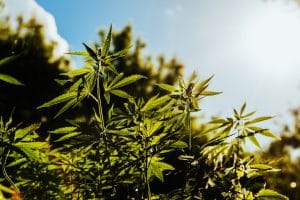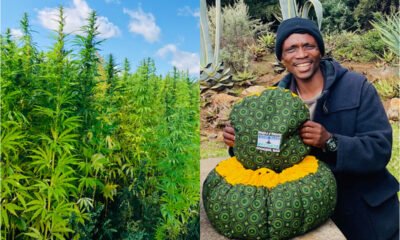As the world watches the events of the United Nations Climate Change Conference 2021, in Glasgow, we examine if hemp could play a part in the reduction of carbon emissions.
Earlier this year, the IPCC report on climate change revealed the shocking state of the environment with a code red warning.
The Intergovernmental Panel on Climate Change (IPCC) report didn’t hold back on the damage done to the planet by greenhouse gasses. The assessment found that the 1.5C warming target will be breached without ‘immediate, rapid and large scale reductions in greenhouse gas emissions.”
The landmark United Nations review predicts the earth will see more heatwaves, flooding and drought over the next twenty years as we move towards the target. It states the rate of warming over the last 2000 years has been ‘unprecedented’ and it is ‘unequivocal’ that human influence has played a part in making the world hotter.
So what can we do? While there are smaller changes we can make, it comes down to potentially changing our industries. We examine how hemp could play a part in contributing to reducing our emissions and environmental damage.

Climate change and….. bioaccumulation
Hemp has the potential to absorb carbon dioxide which contributes to climate change. The greenhouse effect is caused by gases in the atmosphere such as carbon dioxide trapping heat. Humans contribute to these gases by burning fossil fuels like coal. This creates more carbon dioxide in the atmosphere which will in turn trap more heat causing the earth to heat up.
A hemp field could absorb up to 15 tonnes of CO2 per hectare and it converts quickly. It absorbs more carbon dioxide than any other crop or commercial forestry. Hemp consumes four times more CO2 than trees but grows much faster in just 12 to 14 weeks.
Read more: Nicotine dependency: Could CBD help with withdrawal symptoms?

Climate change and….human and animal foods
The food industry can put huge strains on the environment. Soy in particular has caused widespread damage to areas like the Amazon rainforest. It’s not just the growing popularity of soy milk but soybeans are grown in large quantities to feed cattle for meat and dairy production. Large areas of the Amazon forest have been cleared to plant more soybeans.
Hemp can provide an alternative feed for animals after the waste material such as the hemp seed meal which is left after oil is extracted. It can also be made into silage. Hemp leaves can make excellent absorbent bedding for animals. Hemp seeds are commonly used as birdseed mixes.
But it’s not just the animals that can benefit from eating hemp. It’s a great source of nutrients and vegan-friendly protein with essential amino acids. It is made into flour, milk, oil, cooking pastes, seeds and protein powders for human consumption.

Climate change and…… plastic production
Plastic pollution is a huge problem, especially in our oceans. As it is not biodegradable, the small parts, bottles or Microparticles sit in our seas growing in size to the point where we could have more plastic than fish if we continue. A report from 2016 estimated the ocean is expected to contain one tonne of plastic for every three tonnes of fish by 2025, and by 2050, more plastics than fish.
Not only that but the smaller particles can be eaten by fish or animals which then ends up on our plates. Unhealthy chemicals such as polyvinyl chloride (PVC) or bisphenol-A have also been linked to hormone disruption and cancer. Even in landfills, over time the hazardous waste can leak into the soil causing further damage.
Hemp can be made into a variety of different objects as a plastic alternative that is biodegradable. Once the fibres have been removed from hemp stems then what remains is 77 percent cellulose. It’s a light source that could replace dangerous petrochemical plastics. Hemp plants can also lock in carbon helping to clean air and soil. This is why hemp plants were planted after the Chernobyl disaster in 1986.

Learn: What is the difference between hemp seed oil and CBD?
Climate change and…..Fossil fuels
Surprisingly, hemp can also be made into an alternative for coal, oil and gas. The plant contains cellulose and fibre that can be used to create fuel or energy.
Burning fossil fuels or oils can produce thick black smoke that flows downward as well as rising into the atmosphere impacting air quality. Oily residues in water can also contribute to environmental damage.
Using hemp biomass fuel could be a more environmentally friendly alternative to fossil fuels that releases less CO2 into the atmosphere. The first step to producing hemp fuel is to shred the harvested plants before heating with chemicals so that cellulose is released. Enzymes then break down the cellulose into sugars. Adding microbes help the sugar to ferment into ethanol. This ethanol is then purified and distilled to leave the biofuel.

Climate change and…..fast fashion
Fast fashion can be incredibly destructive to the environment. The impacts of the industry are the production of 92 million tonnes of waste each year. It also uses 1.5 trillion litres of water alongside the use of dangerous chemicals and high CO2 emissions. The fashion industry produces 10% of global carbon dioxide emissions every year.
Not only that but polyester, acrylic and nylon make up about 60 percent of our clothes. These synthetic fabrics are plastic and when they are washed, they create microplastics that enter the ocean.
When it comes to denim, a huge amount of water is used in the production of and entire rivers in China have been destroyed by the dyes. The pearl river on the banks of the Chinese town of Xintang in Guangzhou which is referred to as the blue jean capital of the world due to its factories now runs dark blue.
Companies are turning to slow fashion to help counteract the damage. They use hemp to make materials such as hemp fabric, denim and fur. They offer a biodegradable yet durable alternative that is often incredibly breathable. As hemp has anti-microbial properties, it can help to prevent odour causing bacteria in fabric.
Even big brands are listening. Levi’s has created an entire line of hemp denim. The Levi’s Wellthread Collection was created with a waterless dyeing technology, that uses up to 70 percent less water compared with conventional dyeing. The hemp that was sourced from a rain-fed hemp crop, reduced the water used in fibre cultivation by roughly 30 percent.
Read more: Could medical cannabis help with the symptoms of a migraine?

 News6 months ago
News6 months ago
 Science5 months ago
Science5 months ago
 Industry6 months ago
Industry6 months ago
 News6 months ago
News6 months ago
 News5 months ago
News5 months ago
 Health5 months ago
Health5 months ago
 News5 months ago
News5 months ago
 Health3 months ago
Health3 months ago

















